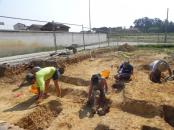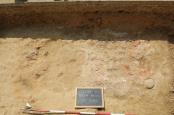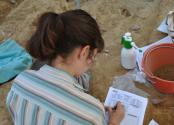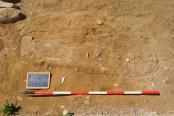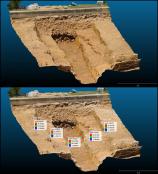CAMPAGNA 2015 |
1° SETTIMANA |
2° SETTIMANA |
3° SETTIMANA |
4° SETTIMANA |
5° SETTIMANA |
6° SETTIMANA |
03 LUGLIO 2015 
Resoconto della giornata di scavo
Area 2000
Il gruppo si è concentrato interamente sui Settori B dell’Area 2000 e dell’area 1000. Il livello raggiunto ha permesso di identificare alcuni tagli allungati collocati su diverse porzioni dell’area, tutti orientati Ovest Est, e che presumibilmente risalirebbero ad una fase più antica rispetto al muro, collocato tra il Settore 2000 B e il Settore 2000 A, datato relativamente al XV secolo. Almeno due di questi (il primo nell’angolo Sud Occidentale, il secondo nell’angolo Nord Orientale) sono stati intercettati centralmente dalle sepolture del colera indagate lo scorso anno. Un terzo taglio (US -2581 = US -1300) risulterebbe una sorta di trincea che percorre, per tutta l’estensione al centro, i settori B delle due aree. All’interno di questa è stato parzialmente messo in luce un individuo malamente preservato del quale non era stato inizialmente identificato il taglio; la trincea secondo le prime osservazioni stratigrafiche sarebbe più antica. L’indagine sarà approfondita la prossima settimana nella speranza di chiarire la natura dei tagli e la loro datazione assoluta.
The day began with additional leveling of section B via pickaxing and troweling. The section was sprayed with water so to better reveal deviations in soil color. Indeed, some were found, mostly in the central northern portion. GIS points were taken, but since the boundaries of the discolorations were unclear, we repeated cleaning and spraying. This exposed distinct delimitations in a possible grave cut as well as a trench running east/west through the area, just north of the cut. This trench was expected due to the existence of one in area 1000, which is directly east to section B. The possible grave cut was oriented the same direction, so we think it will be a grave dating to Medieval times. We began excavating the trench, but before reaching the bottom, we discovered a skeleton in poorly preserved condition. Excavation of the skeleton began promptly but is difficult, and remains to be completed next week.
Area 3000
La seconda settimana di scavo si è conclusa con la documentazione e successiva rimozione dell’inumato USK 3549, orientato W-E e deposto in decubito dorsale all’interno di US – 3547, nella porzione sud-occidentale del Settore B. Più al centro sono stato messo in luce ciò che rimane dell’un individuo USK 3558, orientato W-E e deposto supino in US – 3556; del defunto, mal preservato, si conservano solamente le ultime coste, alcune falangi delle mani, parte della colonna vertebrale e del bacino e alcuni frammenti della porzione prossimale della tibia e della fibula sinistra. La parte superiore del corpo è stata tagliata dalla fossa sepolcrale US – 3402, orientata S-N, mentre quella inferiore dalla tomba US – 3535; L’assenza della porzione centrale è dovuta probabilmente ad un’azione meccanica causata durante i lavori di ampliamento dell’area verso ovest. Gli arti superiori sono stati invece intercettati ed asportati da altri due tagli, che saranno indagati nei giorni seguenti.
Today in area 3000/B, we successfully documented and excavated USK 3549. We also located and cleaned more possible burials in the south western sector of area B. In the south-eastern area, we located and excavated a small cut grave, consisting of lime and a mandible and ribs of a baby. We also continued excavation of 3558, which consists of mainly just the ribs and pelvis, with the middle portion of the body largely missing, likely due to modern work.
Area 5000
Continua lo scavo della zona occidentale dell'area, il quale sta portando alla luce quello che parrebbe essere un piano di calpestio relativo alle fasi di XIV secolo, denominato US 5186. Questo strato è caratterizzato dalla presenza di numerosi laterizi e tracce di malta pressati così da rendere la superficie molto compatta. Questa US è tagliata dalla buca subcircolare US -5185, il cui riempimento ha restituito numerosi frammenti ceramici di tarda età medievale. Sarà molto utile e interessante indagare a fondo questa porzione di area, la quale sembra aver conservato una sedimentazione non alterata dai recenti livellamenti del terreno, in seguito alla messa in opera dell'asfalto stradale.
Like the previous days, area 5000 split into groups. The first group began removing the fill of a trench found on the west side of the mortar pit, up against the end of the site. It was brought down approximately seven inches to expose a deeper level of yellow clay. Two continued to excavate and identify the perimeters of US 5183, the fill of which was identified yesterday. It was determined that the adjacent area to the north and west were of separate fills. Thus, US 5183 was expanded and now labelled US -5183. Within this fill, pieces of glass and animal bone were recovered. Once said section was cleaned, it was photographed. From there, another layer was removed south of the hole towards the mortar pit. This exposed more bricks and clay and was photographed accordingly. From there, a similar procedure was carried out to the north. All this was done to determine the relationships between the various fills in the area and will continue next week.
Area 6000
E' proseguita la messa in luce della sepoltura USk 6023 e della riduzione US 6024, sulla fascia settentrionale dell'area ed in prossimità del cantonale settentrionale della facciata originaria della chiesa di San Pietro. Nell'area della trincea è proseguita la rimozione del riempimento US 6013; la situazione che si sta delineando da questa indagine sta confermando la presenza di (almeno) una tomba a cassa litica intercettata, ai primi del XX sec., dall'azione di canalizzazione US -6007.
Much like yesterday, today in Area 6000, we continued to carefully expose the cut in the fill of Area 6013 which was filled with bone fragments from at least two burials. These two burials do not contain much, if any at all, articulated bone since one of the slabs from the trench slid down some point in history and altered the position of its contents. Most of the bones in 6013 were tiny, unidentifiable fragments or shafts from long bones, but two mandibles with a few teeth each were found mostly in-tact. A minimum of two tibias, a femur, and part of a pelvis were uncovered in Area 6021/6024 which is likely all the bones that will be in that area. Finally, near the end of the day, we continued to define the cut in Area 6003 and indicate the presence of surface bones for future excavation near the rocks of the tombs.







